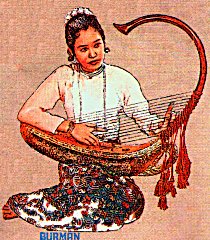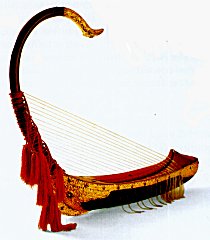C. FONG SHOU KONG HOU � A Phoenix Bird Head

Figure C-1
At the beginning of the Dong Jin Dynasty (317 � 420 A.D.), the Fong Shou Kong Hou was introduced into China from India, as traders traveled through the Middle East or Asia Minor along the Silk Road. In India, this instrument called the Vina disappeared gradually during the Gupta Dynasty (300 � 500 A.D.). Yet the traditional Vina was retained in Burma, Cambodia, and Java to the present day. In Burma, its name was the Tsuan.
During the 53rd year of the reign of Ch�ien Lung (1788), the Burmese Ambassador donated a Tsuan to the Emperor as a gift. The traditional design of the Vina is also the Fong Shou Kong Hou.

Figure C-2

Figure C-3

Figure C-4